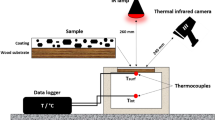Abstract
Waxes are used as water repellent in wood composites, and there are only limited alternative water-repellent systems for wood composites. The aim of this study was to investigate the effectiveness of a silicone compound as a water repellent for flakeboard and to compare the properties of boards made with silicone treated flakes to those made with commercial wax treated flakes. Three levels of silicone and wax application rates were used (0.25, 0.5, and 1%). The hydrophobic nature of silicone-treated flakes was evaluated by measuring the contact angle and the rate of water absorption (WA) on the surface of the wood flake. The internal bonding strength (IB), the modulus of elasticity (MOE) and modulus of rupture (MOR) in bending regime, the WA, and the thickness swelling at edges of boards were evaluated. Results obtained showed that IB, MOE and MOR decreased as the concentration of silicone on the flakes increased from 0.25% to 1%. The IB, MOE and MOR of panels made with 0.25% silicone-treated flakes were comparable to boards made with 1% wax-treated flakes. Thickness swell at edges and WA were significantly reduced as the amount of silicone increased. No significant difference was found for the thickness swelling at edges and the WA between panels made with 1% silicone-treated flakes and 1% wax-treated flakes. The silicone treated flakes had high water repellency.
Zusammenfassung
Wachse werden üblicherweise als wasserabstoßende Mittel in Holzwerkstoffen verwendet, und es gibt nur begrenzte alternative Chemikalien, um einen wasserabstoßenden Effekt in Komposit-Werkstoffen zu erzielen. Ziel dieser Studie war es, die wasserabstoßende Wirksamkeit von Silikonen zu prüfen und die Eigenschaften der so hergestellten Platten mit kommerziellen wachs-behandelten zu vergleichen. Drei Bereiche von Silikon- und Wachs-Anteilen wurden geprüft (0,25, 0,5 und 1%). Die hydrophoben Eigenschaften der mit Silikon behandelten Späne wurde abgeschätzt mittlels Kontaktwinkel-Messung und anhand des Ausmaßes der Wasseradsorption an der Oberfläche der Späne. Gemessen wurde die Querzugfestigkeit (IB), MOE, MOR (Biegung), die Wasserabsorption sowie die Dickenquellung an den Kanten der Platten. Es zeigte sich, dass IB, MOE und MOR abfielen, wenn die Konzentration an Silikon von 0,25 auf 1% anstieg. IB, MOE und MOR von Platten aus Spänen mit 0,25% Silikon waren vergleichbar mit Platten, deren Späne mit 1% Wachs behandelt waren. Dickenquellung und Wasserabsorption zeigten sich mit steigendem Silikongehalt deutlich erniedrigt. Platten, die aus Spänen mit 1% Silikon- oder 1% Wachs-Behandlung hergestellt waren, zeigten keinen signifikanten Unterschied in der Dickenquellung. Die Wasserabstoßung war bei Silikon-behandelten Späne höher.





Similar content being viewed by others
Literature
American Society for Testing and Materials (ASTM) (1999) Book of standards. West, Philadelphia
Avramidis S, Smith LA (1989) The effect of resin content and face-to-core ratio on some properties of oriented strand board. Holzforschung 43(2):131–133
Chambers B, Kamdem DP (1998) Silicone coatings and wood/cement composites. Silicone in coatings II. A technology Forum Exploring the versatility of Silicone. 24–26 March 1998, Orlando
Clad W (1985) Trial manufacture of lightweight particleboard with improved swelling properties. Holz-Zentralblatt 111:32, 514
Grossman LM (1992) Expanding your OSB markets with protective coatings. In: 26th International Particleboard Composite Materials Symposium, Pullman, pp 227–235
Hager R, Mayer H (1994) Waterborne silicones for wood protection. In: Paper presented at the 4th Asia Pacific Conference, May 1994
Maldas D, Kamdem DP (1999) Wettability of extracted southern pine. For Prod J 49:91–93
May HA, Roaffael E (1984) Increasing the water repellency of particleboards with paraffin waxes. 4. The effect on board properties on industrial waxes of various composition. WKI-Mitteilungen. No. 376. Wilhem Klauditz Institute. German Federal Republic. p 6
Nzokou P, Kamdem DP (2002) Weathering of two hardwood species: African padauk (Pterocarpus soyauxii) and red maple (Acer rubrum). J Trop For Prod 8(2):200–209
Rochow EG (1987) Silicon and silicones. Springer, Berlin Heidelberg New York, p 143
Schneider MH, Brebner KI (1985) Wood-polymer combinations: the chemical modification of wood by alkoxysilane coupling agents. Wood Sci Technol 19:67–73
Winistorfer PM, McFarland DL, Slover RC (1992) Evaluating the performance of ten wax formulations and three application rates on properties of oriented strand board. In: 26th International Particleboard Composite Materials Symposium, Pullman, pp 236–250
Zhang HJ, Gardner D, Wang JZ, Shi Q (1997) Surface tension, adhesive wettability, and bondability of artificially weathered CCA-treated southern pine. For Prod J 47(10):69–72
Acknowledgements
The authors wish to acknowledge Michigan State University-Eastern Hardwood Utilization Program USDA/CSRS grant #02-34158-2697 for providing funds.
Author information
Authors and Affiliations
Corresponding author
Rights and permissions
About this article
Cite this article
Jusoh, I.B., Nzokou, P. & Kamdem, P. The effect of silicone on some properties of flakeboard. Holz Roh Werkst 63, 266–271 (2005). https://doi.org/10.1007/s00107-004-0550-6
Published:
Issue Date:
DOI: https://doi.org/10.1007/s00107-004-0550-6




